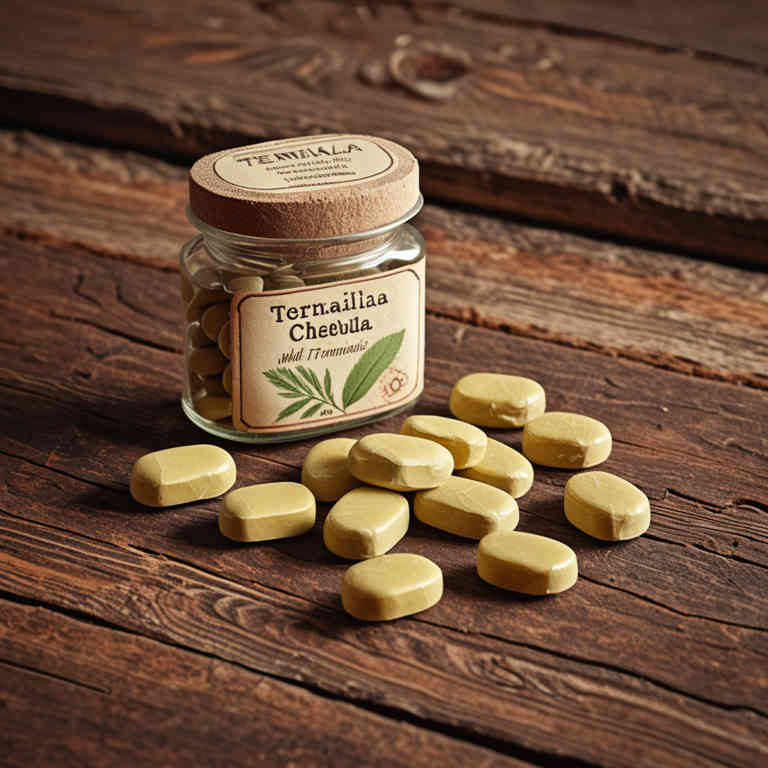Terminalia chebula lozenge for medicinal use

Terminalia chebula lozenge is a traditional herbal preparation made from the fruit of the Terminalia chebula tree, commonly known as the chebulic myrobalan.
It is used in herbalism for its purported digestive and respiratory benefits, often to soothe sore throats and aid in digestion. The lozenge form allows for easy consumption and prolonged contact with the mouth, enhancing its therapeutic effects. It is traditionally used in Ayurvedic medicine to support gut health and reduce inflammation.
This preparation is also believed to have antioxidant and antimicrobial properties that contribute to its medicinal value.
Uses
Terminalia chebula lozenge has been used to support respiratory health and alleviate sore throat symptoms for centuries in traditional Ayurvedic medicine.
Historically, it was valued for its antimicrobial and astringent properties, making it a popular remedy for coughs, inflammation, and oral infections. In modern times, it is increasingly used as a natural supplement to boost immunity and reduce throat irritation due to its high content of tannins and antioxidants. The lozenge form enhances its palatability and allows for direct application to the throat, improving its therapeutic efficacy.
Today, it is also incorporated into herbal formulations for its potential anti-inflammatory and digestive benefits.
Benefits
Terminalia chebula lozenge has health benefits such as supporting respiratory health, boosting immunity, and promoting oral hygiene.
It is traditionally used to alleviate sore throat and cough due to its anti-inflammatory and antimicrobial properties. The lozenge contains tannins, which can help reduce mucus production and soothe irritated tissues in the throat. It is also believed to aid in digestion and may contribute to overall digestive wellness.
Regular use of Terminalia chebula lozenge may enhance the body's natural defenses against infections.
Constituents
Terminalia chebula lozenge active constituents include tannins, chebulinic acid, gallic acid, ellagic acid, and various flavonoids.
These compounds contribute to the lozenge's traditional use in promoting oral health and reducing inflammation. Tannins and gallic acid are known for their astringent properties, which can help in soothing sore throats and reducing bacterial growth. Ellagic acid and flavonoids may support antioxidant activity, potentially aiding in the prevention of oxidative stress-related conditions.
Overall, these active constituents make Terminalia chebula lozenge a popular choice for supporting respiratory and digestive health.
Preparation
To make Terminalia chebula lozenge, first gather the dried fruit of Terminalia chebula, commonly known as chebulic myrobalan.
Wash and chop the fruit into small pieces, then grind it into a fine powder using a blender or mortar and pestle. Next, mix the powder with a binding agent such as honey or a small amount of water to form a thick paste. Shape the paste into small lozenges using a mold or by hand, and allow them to dry in a cool, dry place for several days until they harden.
These lozenges can then be stored in an airtight container and used as a natural remedy for sore throat and digestive issues.
Side Effects
Terminalia chebula lozenge may lead to gastrointestinal discomfort such as nausea, vomiting, or diarrhea in some individuals.
It can also cause allergic reactions in people sensitive to the plant's components. Prolonged use may result in liver toxicity, especially when taken in high doses or combined with other hepatotoxic substances. There is limited research on its long-term effects, so caution is advised for pregnant or breastfeeding women.
Always consult a healthcare provider before using this preparation, especially if you have pre-existing medical conditions.